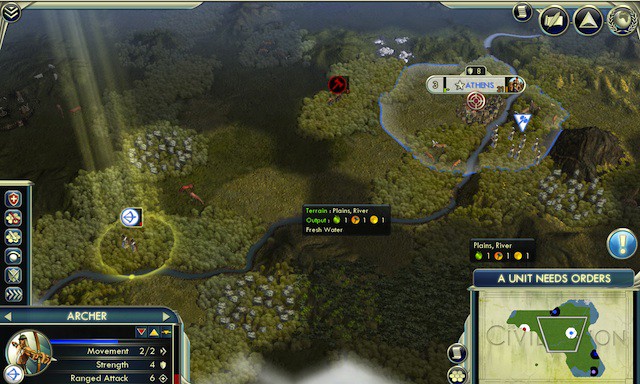I have a friend I once queried about the contents of his PC gaming library. He looked at me a little quizzically, then replied that he had the only game one ever need play: Civilization. In that instance, it happened to be Civilization 4, Civ 5’s immediate PC predecessor, arguably considered the finest version of the series since Sid Meier’s original 1991 masterpiece.
He’s not alone. Press any gamer for a name that defines the category of turn-based strategy, and the answer will almost invariably be “Civilization.” Intelligent, beautifully crafted, incredibly detailed with finely honed gaming mechanics, the games are as much a beauty to behold as they are immensely satisfying to play.
The latest installment, Civ 5 ($40), released for the Mac late last year and recently added to the Mac App Store, is the biggest departure from the series since the original.
Wait, I’m new to this whole Civilization thing. What’s the deal?
Man, have you been missing out. I’m not going to be able to explain the game with the kind of detail it deserves, but here’s a taste.
The Civilization series sits at the very pinnacle of the empire-building genre. To win the game, the player must balance production of military or worker/expansion unit and civic improvements, defend borders from assault (or, for the aggressive player, expand into enemy territory), all the while keeping a (hopefully) burgeoning population happy by keeping negative influences — high taxes, pollution and war — to a minimum, and offsetting the unhappiness with culture and civic improvements (buildings).
Like all really brilliant games, it balances the openness of a sandbox with guided play. For instance, there are several paths to victory instead of just one, some of which include: A diplomatic victory through being nice to everyone, winning the space race by getting your cities to build parts of a giant spaceship that’ll take your people to Alpha Centauri, or just good ol’ all-out war with every other competing civilization on the map until no one else is left.

Ok. So much does Civ 5 differ from previous versions?
A ton. Like I said, Civ 5 is the biggest departure from the genre, and seems to veer wildly toward Civilization Revolutions, a streamlined version of the game developed for consoles, the iPhone/iPod and the iPad.
All the basic stuff is there, and players of previous versions will instantly recognize the basic elements: the paths to victory, the tech tree and unit types, for instance, are all more or less identical. But the mechanics have been altered significantly to require less micro-management from the player.
One of the largest changes, for instance, is in how happiness is calculated. Previously, the level of happiness was city-based, with each city’s level a separate entity, affected by a mixture of global (is your nation at war? Citizens won’t like that) and local influences like civic improvements (a theatre goes a long way to keeping people happy); instead, local tweaking like building civic improvements now affects a nation-wide happiness level.
Another change is the addition of vassal states, sort of lite versions of AI-controlled opponents. Each map starts out with a varying amount of these city-states (that never grow beyond a single city) that will hinder or help your cause based on their stance toward you. Fulfill their requests (the may want access to a precious resource, or ask you to defend them against an enemy) and they might turn onto an ally, which comes with certain benefits.
Combat, and movement on the other hand, has been made more realistic: The squares that Civilization maps have been divided up with since the beginning have been abandoned in place of more wargame-like hexes; unlike any previous version of the game, there are ranged units (cannon, archers etc.) that can attack without taking damage themselves; and combat modifiers are more varied and complex — for example, just having other friendly units next to your unit will grant modest bonuses.
A big surprise was how dumbed down the AI seemed, especially when compared with the computer’s cunning in the last version. I missed the clever, massed surprise attacks the AI would confound me with in Civilization 4, and there were many instances where my computer opponent seemed downright schizophrenic, giving up well-prepared defensive positions and moving off, only to return to the same spot the next turn — this happened over and over, with no influence from me influencing the bizarre ritual.

What about speed? I’ve heard it bogs down on older systems; will it play on my system?
Yeah, and it’s kinda weird. For a game that doesn’t require simultaneously animating a ton of separate pieces like a real-time strategy title or have the spectacular effects of one, Civ 5 is horribly slow. My 13” MBP (2.4 GHz Core 2 Duo, 4 GB memory, NVidia GeForce 320M) isn’t even a year old and meets the minimum requirements (though barely), yet I was having all kinds of trouble just getting the screen to scroll. Moving around the map, zooming in and unit animations all prove jerky and slow on anything but the lowest graphic settings — which actually make the game look pretty ugly.
So should I get it?
There’re some welcome changes, like the hexes and beefed-up combat system. But the game mechanics that have been tweaked to require less micro-management, overly specific help from your advisors and somewhat weak effort from the computer opponent give this iteration of Civ a watered-down feel, changed to purposefully target — wisely or not — a wider audience.
If you’re a diehard Civilization fanatic, Civ 5 won’t be Civilization as you know it — you might find the franchise’s new direction disappointing and ultimately unfulfilling. And if your machine has anything less than the minimum requirements, don’t even glance at it. But casual-ish gamers with new and/or powerful machines looking for an immersive, attractive strategy game should find endless hours of enjoyment in Civ 5. Even with the changes, it’s still one of the best examples of the strategy genre; just not the brilliant gem it was previously.
[xrr rating=80%]
Minimum recommended requirements:
2.4 GHz Core 2 Duo processor, 2 GB RAM, 6 GB storage, 256 MB Video RAM
(note that the version at the App store is the Campaign Edition, which includes the Babylon and Mongols Civilization packs, and extra scenarios)


![Empire Building Sees Big Changes in Civilization V [Review, FAQ] civv2a](https://www.cultofmac.com/wp-content/uploads/2011/07/civv2a.jpg)

